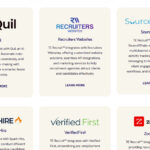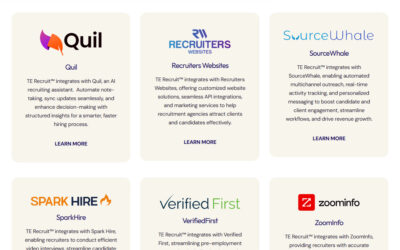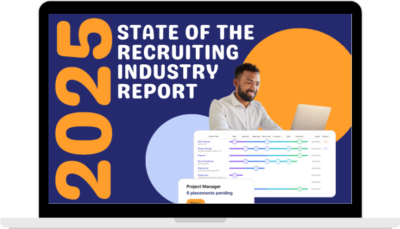(Editor’s note: The information from this article by Top Echelon Recruiting Software has been taken from an Expert Recruiter Coaching Series webinar by Barb Bruno, CPC/CTS of Good as Gold Training titled, “Counteroffers Are the New Retention Tool.” Click HERE to watch the video of that training webinar for free.)
In today’s hyper-competitive talent market, counteroffers are no longer a surprise—they’re the new normal. Whether you’re an experienced recruiter or new to the industry, you’ve likely encountered this challenge. Candidates are accepting offers only to turn around and accept a better one from their current employer, leaving recruiters frustrated and clients blindsided.
According to Barb Bruno, CPC/CTS, President of Good as Gold Training, counteroffers are now the go-to strategy for employee retention, and if you’re not proactively addressing them, you’re losing placements and money.
“Counteroffers have always existed, but it’s no longer a question of if your candidate will get one—it’s when,” Barb explained. “They’ve become a standard part of the retention strategy for employers who can’t afford to lose key talent.”
In this article, we’ll break down the key reasons why counteroffers are on the rise and how recruiters can proactively reduce the chances of a counteroffer being accepted. We’ll also explore the techniques Barb and her team use to maintain a nearly flawless record of counteroffer prevention.
Why Are Counteroffers on the Rise?
From the Candidate’s Perspective:
- Marketable Talent Knows Their Value: With demand for skilled talent at an all-time high, candidates know they’re in the driver’s seat. Many are aware that they’re underpaid and can use external offers as leverage.
- Salary Transparency and Laws: The rise of salary ban laws across 17 states and multiple municipalities has eliminated the practice of offering salaries based on prior earnings. As Barb noted, “Now they’re being paid what they’re worth.”
- Strategic Interviews: Candidates are increasingly using interviews not to change jobs, but to generate counteroffers. “They love their job, but want more money. So they use you,” Barb emphasized.
- Unfair Internal Pay Disparities: Many employees resign simply because they discover that new hires are earning significantly more than they are.
- Continuing to Interview: Even after accepting an offer, candidates often continue to interview elsewhere, making your offer just one of several options.
- Self-Interest Rules: As Barb bluntly stated, “Every person you talk to has a tattoo on their forehead: ‘What’s in it for me?’”
From the Employer’s Perspective:
- Talent Shortage Crisis: Companies are desperate to retain experienced talent because they can’t afford to keep critical roles vacant for months.
- Retention and Engagement Struggles: At a recent CEO conference Barb attended, 50% of sessions focused on how to engage and retain employees. “They’re even running sessions on how to win back people who’ve already quit,” she said.
- Counteroffers as Damage Control: Employers are aware that many of their top performers are underpaid, but they can’t afford across-the-board raises. Instead, they offer sizable counteroffers to keep those who threaten to leave.
- Retention Bonuses: Some companies are now adding bonuses on top of raises and promotions to sweeten counteroffers further.
“They know it’s a short-term fix,” Barb said. “But they hope it buys them time to find a long-term solution.”
Seven Proven Techniques to Reduce Counteroffer Acceptance
Barb shared seven specific strategies her team uses to proactively combat counteroffers—and the results speak for themselves.
“We haven’t had a counteroffer accepted since the beginning of the year,” she revealed. “And we’ve had many extended.”
1. Re-Interview Candidates Throughout the Process
The first interview is rarely enough. Candidates are guarded and often influenced by previous bad recruiter experiences.
Barb recommends asking these six questions to uncover motivation and identify red flags:
- What are the five things you’d change about your job if you were your boss?
- What must be there for you to accept a new opportunity today?
- What job offers have you received and turned down?
- What is your target date to accept a new position?
- What are your short- and long-term goals?
- What other opportunities are you currently considering?
“If they only say money or advancement, they’re likely using you for a counteroffer,” Barb warned.
2. Ask: “What Will You Do If You Get a Counteroffer?”
Be direct. Barb suggests recording their answer verbatim.
“When they say, ‘I’d never accept one,’ write it down and tell them: I’m going to read your words back to you when that counteroffer comes in.”
This technique is powerful. It reminds candidates of their true motivations and helps them resist emotional, last-minute decisions.
3. Obtain Performance Objectives From Clients
Most job descriptions are laundry lists of skills. Instead, ask hiring managers how they will evaluate the new hire in six to twelve months.
Share those performance expectations with the candidate.
“When candidates know how they’ll be evaluated, it increases engagement and retention,” Barb explained.
4. Sell Against Counteroffers Throughout the Process
Talk about counteroffers early and often. Start every candidate and client conversation with: “Has anything changed since the last time we talked?”
“You can’t just talk about counteroffers once and hope it sticks,” Barb said. “Bring it up again and again.”
5. Quantify the Candidate’s Level of Interest
Don’t accept vague statements like “I’m interested.” Ask:
“On a scale of 1 to 10, with 10 meaning you’d accept the offer today, where are you?”
A 4 means you’re not as close as you think. Ask why they didn’t say 10.
6. Limit the Notice Period
Never allow more than a two-week notice unless relocation is involved. Longer notices give candidates time to entertain counteroffers or additional interviews.
7. Recognize That Counteroffers Don’t Stop at Start Date
Candidates may receive counteroffers weeks—or even months—after they’ve started their new role, especially if their replacement doesn’t work out.
“Stay in touch after the placement. If you stop calling after you get paid, you’ve proved them right that you only cared about the money,” Barb said.
Coaching Clients on Counteroffers
When clients see you as a trusted advisor rather than a vendor, they’ll be more open to your coaching.
Use data from SHRM, LinkedIn, and industry studies showing that 80% of candidates who accept counteroffers leave within a year.
Ask your clients:
- How far are you willing to go to revise your offer?
- Can you offer remote or hybrid work?
- Are you providing training and development opportunities?
Millennials and Gen Z care deeply about learning and career advancement. Make sure your clients are speaking to those desires.
Where Most Recruiters Drop the Ball
Barb didn’t mince words.
“Most recruiters are so busy chasing the next job order that they forget about the placement they just made.”
But follow-up is critical to preventing counteroffers.
Establish a follow-up system that includes:
- A check-in after offer acceptance
- A call on the candidate’s first day
- Weekly check-ins during the first 30 days
- Monthly follow-ups for the first six months
Ask if they’ve heard from their previous employer. If they have, remind them of what they said they’d never tolerate again.
Also, ask clients how they feel about the new hire. This helps build long-term relationships—and future business.
Final Thoughts: Become a Lifetime Career Agent
To truly prevent counteroffers from sabotaging your hard work, you need to shift your mindset. Be more than just a recruiter. Be a career partner.
“I believe we should become a lifetime career agent to our candidates and a friend to our client,” Barb said. “People want to know you care about them, that they can trust you, and that you’ll do what you said you would do.”
You’re not just filling jobs. You’re building futures. And in a market where counteroffers are the norm, only those who invest in relationships will win.
So if you’ve been struggling with counteroffers, remember Barb’s message: this is not hopeless. You just need a better process, a clearer strategy, and a deeper commitment to serving both your clients and candidates.
As Barb summed it up: “People will judge you on what you do—not what you say.”
Follow Barb Bruno on LinkedIn to access her free training articles and updates from Good as Gold Training. For recruiters ready to elevate their process, prevent counteroffers, and make more placements, these strategies are your blueprint.









